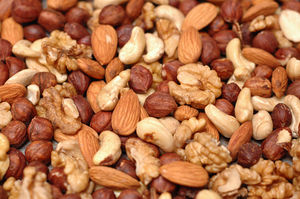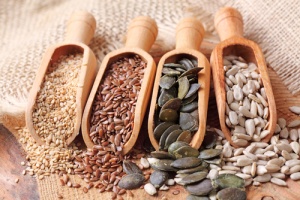Nuts and seeds
| See Also | Clinical Nutrition |
|---|
A nut is a dry, hard, one-seeded fruit consisting of a kernel that is usually oily and surrounded by a protective hard or brittle shell. Most nuts are the seeds or dried fruits of trees and do not opening at maturity which is known as indehiscent. The edible seed that is eaten (e.g. pumpkin and sunflower seeds) grow on vegetable or flower plants and their hulls are sometimes edible because they are softer than those of nuts. [1]
Contents
Classification
Nuts and seeds are classified as follows:
- True Nut: In true nuts, the hard, indehiscent layer surrounding the seed is the entire ovary wall (pericarp), and the outer husk is composed of involucral tissue that is not part of the ovary wall or pericarp.
- Chestnuts, filberts, and walnuts are considered to be true nuts
- Botanical Seed: Is the term given for cashews, brazil nuts, pistachios and legumes (e.g. peanut).
- The peanut is considered to be a legume because it bears fruit in the form of pods (shells) that contain one or more seeds (usually two per pod).
- Drupe: A drupe is a fleshy fruit with a hard inner layer (endocarp or stone) surrounding the seed (e.g. almonds).
- Some botanists also include the fruits of walnuts, cashews, pecans, macadamia nuts, and pistachio nuts as drupes because of their outer, green, fleshy husk and stony, seed-bearing endocarp.
- The coconut is considered a dry drupe with a green, waterproof outer layer (exocarp), a thick, buoyant, fibrous husk (mesocarp) and a hard, woody, inner layer (endocarp) surrounding the large seed.
Nutritional Value
While nuts and seeds are a diverse class of food, they do share some common health benefits including: [2], [3], [4], [5]
- They are rich in both nutrients and anutrients such as fiber, protease inhibitors, ellagic acid and other polyphenols which are necessary for good health.
- Nuts (especially macadamias, almonds, walnuts and cashews) contain heart healthy essential fatty acids linoleic (Omega 6) and linolenic acids (Omega 3).
- Research shows that omega-3 fatty acids reduce inflammation and may help lower risk of chronic diseases such as heart disease, cancer, and arthritis.
- Nuts and seeds are a good source of protein with nuts deriving between 8-18% of their calories from protein, and seeds deriving 11-25%.
- Several studies have revealed that people who consume nuts such as almond and walnuts on a regular basis are less likely to suffer from coronary heart disease, as nuts help lower serum LDL cholesterol concentrations.
- While there are several substances in nuts that have cardioprotective effects, the alpha-linolenic acid (Omega 3) content in nuts plays a big role in this hypolipidemic effect.
- Nuts are a low-glycemic food that produce a feeling of satiety after they are consumed.
- Nuts are good regulators of insulin and blood sugar, preventing steep rises, which makes them a good food choice for people with glucose intolerance and diabetes.
Following are the nutritional benefits of the most commonly consumed nuts and seeds: [6], [7]
- Almonds: Almonds are packed with nutrition and contain more calcium than any other nut.
- They have a high fat content (up to 60%) and are high in calories: 3.5 ounces (100 grams) of almonds provide about 600 calories.
- Almonds are rich in polyunsaturated oils, protein (20%), potassium, iron, zinc, calcium, and vitamin E.
- They have the highest dietary fiber content of any other nut or seed and supply 3 grams of fiber per ounce.
- Almonds have been shown to reduce cholesterol and protect arteries from damage
- Almonds have a high ratio of arginine to lysine (essential amino acids) and should be avoided by anyone susceptible to cold sores or herpes infections as arginine promotes the activation of this virus.
- Brazil Nut: Are similar in nutritive value to almonds but have a higher fat content
- These nuts are a good source of methionine and cysteine (amino acids) and are therefore a great source of protein.
- Due to their high fat content brazil nuts are apt to turn rancid quickly if they are not refrigerated or kept in a dry, cool place.
- Brazil nuts are one of the richest dietary sources of selenium, an antioxidant linked to lower rates of heart disease and cancer.
- One ounce of brazil nuts can contain as much as 10 times the adult recommended daily intake of selenium.
- Cashew Nut: Cashews have a lower fat content than most other nuts but are relatively high in saturated fat.
- Coconuts: These nuts yield milk, oil, meat and meal and as such are the most wildely grown nut crop in the world.
- Nearly all of the fat contained in coconuts is saturated and extremely stable when used in deep frying, shortening, margarines, candies and baked goods.
- The protein content of coconut is much lower than other nuts because it doesn’t contain the amino acids lysine and methionine.
- Filberts (Hazel Nut): The nutritional value of filberts is similar to that of almonds except filberts are higher in fat and lower in protein.
- Macadamia Nut: These nuts contain more fat and calories than any other nut and as such are most often consumed as a dessert nut.
- Peanuts: Peanuts are legumes and contain approximately 50% fat, 26% protein and 19% carbohydrates.
- The fat in peanuts consists of predominantely unsaturated fatty acids (75%)
- Peanuts are very high in protein and are also a great source of B vitamins and minerals specifically magnesium, potassium, iron, zinc and calcium.
- In North America peanuts are primarily eaten as dried or roasted, in candies or in the form of peanut butter which involves processing and consequently diminishes the nut's nutritional value.
- Commercial peanut butter contains hydrogenated oils (trans fats) which keep the oil from separating and have adverse effects on health.
- Peanuts are susceptible to mold and fungal invasions specifically Aflatoxin which is a known carcinogen and 20 times more toxic than DDT.
- To protect yourself from aflatoxin ingestion peanuts must be kept in a dry, cool environment as the fungus grows in humid environments where the temperature is between 86-96 degrees fahrenheit.
- Pecans: This nut is one of the highest in fat (71%) and lowest in protein of all of the nuts and is similar in nutritive benefits to that of the macadamia nut.
- Because of their high fat content pecans should be purchased in their shells.
- Pine Nuts: These “nuts” are actually the seeds of a species of pine trees and the nuts are locked within the pine cone.
- Pistachios: This nut is made up of 55% fat and 20% protein and an excellent source of most B vitamins, iron, magnesium, potassium and calcium.
- It is best to avoid salted pistachios due to their high sodium content and because they have a red dye applied to them during processing.
- Pumpkin Seeds: Pumpkin seeds are packed with nutrition are a great source of essential fatty acids, protein (29%) and minerals.
- They are lower in fat than most nuts and are an excellent source of iron.
- Deficiencies in this seed has been linked to a high rate of benign enlargement of the prostate and evidence shows that supplementing with pumpkin seeds may help reduce this enlargement.
- Pumpkin seeds have also been shown to be effective in ridding the body of intestinal parasites such as helminthes and worms.
- Sesame Seeds: Sesame seeds are very high in oil and have an average oil content of 50%
- The protein (25%) contained in this seed is high in methionine and cysteine which makes it very favourable for vegetarians and vegans.
- Sesame seeds contain Sesamin, a lignan that has impressive antioxidant effects and has also been shown to inhibit the absorption of cholesterol from the diet and lower blood cholesterol levels a great deal.
- Sunflower Seeds: These seeds are a wonderful source of linolenic acid (Omega 3) and as such have been shown to lower blood cholesterol levels and prevent heart disease.
- Walnuts: These nuts are among the most nutritious as they have a very low water content (3-4%), provide good oil levels (60%) and calcium, iron, vitamin E and zinc.
- More than a decade of scientific evidence has shown that incorporating walnuts in a healthy diet reduces the risk of heart disease by improving blood vessel elasticity and plaque accumulation.
- Walnuts have also been shown to aid in the lowering LDL cholesterol and the C-Reactive Protein, the latter of which is an independent marker and predictor of heart disease.
Specific Consideration
Allergies
Nuts are one of the most common food related allergens due to their protein content.
- If you're allergic to tree nuts, the only way to avoid a reaction is to avoid all food and products that contain tree nuts and tree nut derivatives.
- Check labels for precautionary statements such as "may contain tree nuts” and read ingredient lists carefully.
- Learn to identify other names for tree nuts including the following:
- Anacardium nuts
- Filberts (hazelnuts)
- Nut meats
- Pinon
- Queensland nut (macadamia)
Buying and Storing Nuts
Following are some rules of thumb with respect to buying and storing nuts and seeds:
- As a result of their high oil content and the risk of this causing rancidity nuts and seeds are best purchased and stored in their shells.
- The shell will protect against any free-radical damage caused by light and air.
- Ensure that the shells do not have any holes, cracks, split or stains.
- Packages of slivered, crushed and broken nut pieces are usually rancid so it is best to prepare your own from whole nuts if these forms are required.
- Do not eat moldy or limp, rubber, dark or shriveled seeds and nuts as these can cause illness (e.g. candidiasis).
- Store nuts and seeds in their shells in a cool, dry environment or in airtight containers in the fridge or freezer.
Recommended Intake
The recommended intake varies based on age and health status. To determine what your specific requirements are talk to your naturopathic doctor or other trained medical professional.
References
- ↑ Encyclopedia Britannica Tree Nuts http://www.britannica.com/EBchecked/topic/371732/meat Retrieved 20 March 2012
- ↑ Murray M (1993) The Healing Power of Foods Prima Health
- ↑ Margen S (1992) The Wellness Encyclopedia of Food and Nutrition Random House
- ↑ Kelly JH Sabaté J (2006) Nuts and coronary heart disease: an epidemiological perspective 'Br J Nutr;96:S61–S67. Retrieved 20 March 2012
- ↑ Rajaram S et al. (2009) Walnuts and fatty fish influence different serum lipid fractions in normal to mildly hyperlipidemic individuals: a randomized controlled study Am J Clin Nutr;89:1657S-1663S. Retreived 20 March 2012
- ↑ 6.0 6.1 Murray M (1993) The Healing Power of Foods Prima Health
- ↑ 7.0 7.1 Margen S (1992) The Wellness Encyclopedia of Food and Nutrition Random House

